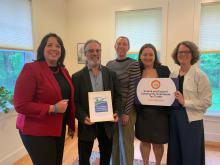On Monday, November 16th, United Way of Massachusetts Bay and Merrimack Valley, MACDC and Boston LISC were joined by Governor Baker and over 120 business, philanthropic and community development leaders to learn more about the Community Investment Tax Credit. MACDC's President Joe Kriesberg had an opportunity to speak - here are his remarks:
Good morning and thank you for coming.
I’m Joseph Kriesberg, President of the Massachusetts Association of CDCs. We serve as the policy and capacity building arm of the community development field and played a key role in enacting the Community Investment Tax Credit.
I also serve on the Local Advisory Board of the Local Initiatives Support Corporation which works to build stronger neighborhoods by investing in CDCs and community based economic development initiatives. Bob Van Meter, the LISC Director, is here with us this morning as well.
We are thrilled to join with our partners at the United Way to co-host this breakfast.
The CITC is rooted in three core values that serve as the foundation of the community development field.
- The first is that people should have agency over their own future – both the future of their community and the direction of their own lives. And we believe that this can best be achieved when we come together as a community to get things done.
- The second is that everyone should have the opportunity to participate in the economic mainstream and achieve their own full potential, regardless of where they live, where they came from or their racial or ethnic background.
- The third core value that we work to advance is “inclusion”. We believe that our communities and our Commonwealth need to include everyone regardless of race, ethnicity, gender, or background --and we believe that we must work to reverse the historic and systemic bias that persists in our society.
For more than forty years, CDCs have put those values into action.
In your packets, you have a copy of our GOALs Report – Growing Opportunities, Assets and Leaders, this is MACDC’s Annual State of the Sector Report. You can see what our members achieved last year. And, if you think those numbers are impressive, listen to what they have achieved over the past ten years:
- Spurred over $3 billion of investment in our communities.
- Created or reserved over 12,500 homes
- Created or preserved over 28,000 job opportunities
- Helped 15,000 entrepreneurs start, stabilize or grow their own business
- Served nearly 400,000 families
These numbers are visible all across the state. You can walk just a few blocks from here to Chinatown and see One Greenway preparing to welcome over 200 new residents to a mixed-income, mixed use development – indeed the ribbon cutting is tomorrow. Or take a walk to the South End and visit Villa Victoria one of the oldest CDC housing developments with over 400 families living in high quality apartments. As you travel further to Roxbury, Dorchester and Jamaica Plain you will see more housing, community & cultural centers, commercial buildings, a Food incubator, a factory, and small business complex and more – all developed by CDCs. Along the way, you will also meet local businesses that received a loan or technical assistance from a CDC, construction workers employed on CDC projects and first time homeowners educated by the CDCs like the Allston Brighton CDC.
But it is not just Boston. Go to the Main South neighborhood in Worcester and see how the CDC partnered with Clark University to completely transform the neighborhood; go to Greenfield to visit the Franklin County Food Processing Center which serves dozens of locally owned businesses; go to Fitchburg and visit the homeowners who were able to keep their home thanks to foreclosure counseling from the NewVue CDC; go to Chelsea and meet the single mothers who are accessing job training and financial coaching services that are putting them on the track to economic stability; go to Cape Cod and talk to the fisherman who are able to maintain their family tradition thanks to a partnership between the CDC and the Hook Fisherman Association.
Success stories like these abound across the Commonwealth.
The CITC was designed specifically to support this diverse array of work. It offers flexible funding that can be deployed based on the unique assets and challenges in each community.
Each CDC works with local residents and stakeholders to submit a detailed Community Investment Plan to the Commonwealth in which they lay out their vision for community improvement. The state selects the best plans and awards them an allocation of tax credits of up to $150,000 a year.
CDCs then use those tax credits to attract new donors and to enable existing donors to give more. Each dollar of state revenue is matched by a dollar of private revenue, creating a stable and diverse revenue stream for these high impact organizations. In fact, the 50% refundable state tax credit, combined with federal tax benefits, means that some individuals can get nearly 80 percent of their donation back.
Donors can be individuals, corporations, small businesses, foundations, universities, hospitals, and donor advised funds. Even those with little to no tax liability can benefit by getting a refund.
The CITC also gives donors three choices about how and where to invest.
- Donors can give directly to one or more of the 47 CDCs participating in the program – there is a list of these groups in your packet.
- Donors can give to MACDC or LISC – the two Community Support Organizations designated by DHCD to provide training, technical assistance and capacity building services to CDCs.
- And, of course, donors can give to the United Way’s Community Partnership Fund which distributes the funding to CDCs across the state.
Last year, this program attracted over 1,000 donors and $4.7 million. This year, with your help, it is poised to double in size.
Together, Governor Baker, the United Way, LISC, the local CDCs, everyone in this room and many others not here today - are building momentum to transform communities and change lives.
Thank you so much for getting involved and for helping us to spread the word.
I'm now honored to introduce Susan Esper, Board Chair of UW and Partner at Deloitte, one of the largest supporters of the program.









